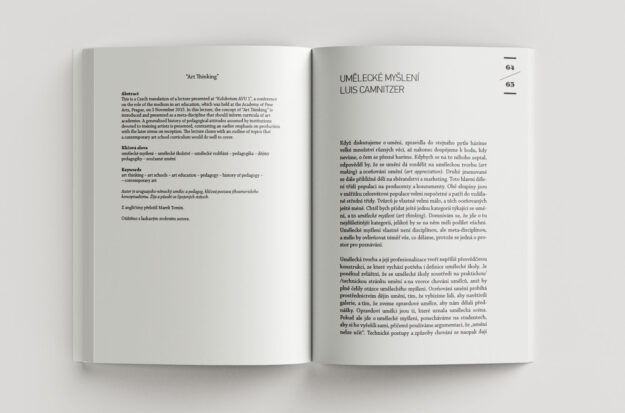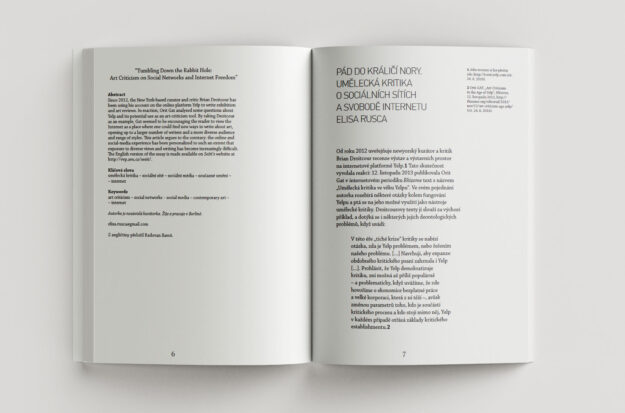At the heart of this issue are three studies following on from the international conference “Art Criticism 2.0”, which took place last November as one of the events surrounding the Věra Jirousová Award. Elisa Rusca warns of the pitfalls linked with using social media for art criticism purposes, pointing out that specialist analyses can be replaced simply by the quantitative measurement of popularity. Eve Kalyva interprets the interplay of social media and contemporary art as part of the broader process of the commodification of culture under neoliberalism. Sebastian Mühl examines the question of the critical evaluation of the outputs of “artistic research” from the perspective of their cognitive and aesthetic status. Theses texts are available in Czech in the printed edition and in the original English in the online magazine. This edition also contains a translation of a text by Luis Camnitzer, in which this renowned representative of conceptual art offers an interpretation of the transformation of the concept of an arts education during the course of the twentieth century, and formulates a manifesto for the emancipation of the process of teaching art from the shackles of the academic world. The edition closes with a review by Slavomíra Ferenčuhová of the essay by Hubert Guzík on the phenomenon of the koldom, or collective house, in Czechoslovakian architecture of the mid-twentieth century.
Content
Elisa Rusca
Tumbling Down the Rabbit Hole: Art Criticism on Social Networks and Internet Freedom
Since 2012, the New York-based curator and critic Brian Droitcour has been using his account on the online platform Yelp to write exhibition and art reviews. In reaction, Orit Gat analysed some questions about Yelp and its potential use as an art-criticism tool. By taking Droitcour as an example, Gat seemed to be encouraging the reader to view the Internet as a place where one could find new ways to write about art, opening up to a larger number of writers and a more diverse audience and range of styles. This article argues to the contrary: the online and social-media experience has been personalized to such an extent that exposure to diverse views and writing has become increasingly difficult.
Eve Kalyva
„Where Are My Keys? The Now of Critique in a Plurality of Voices”
Social media are intrinsic to marketing. They contribute to the intensification of consumerist culture, and, together with prevalent neo-liberal policies across the educational and the cultural sectors, shift the dynamics of our access to knowledge and culture. This causes changes in museum policies and the traditional model of plan–produce–publish and affects the institutional position and validity of criticism. The essay tries to identify these changes and reflect on the state of criticism today. It examines different artworks that use social media, and suggests an interdisciplinary approach that, based on social semiotics, turns attention to the act of communication. By understanding art criticism as interpretation in operation, we can negotiate its position within overlapping discursive frameworks and evaluate the social and critical dimensions of art.
Sebastian Mühl
Artistic Research as a Challenge for Art Criticism
In the last decade, artistic research arose as a new avant-garde practice in the arts. Regarding the dissolution of artistic limits, research-oriented practices increasingly challenged the once inflexible boundaries between art and science. Not only did artistic research challenge well-established notions of scientific knowledge production, but it also confronted art criticism with a number of problems. Considering contemporary theories of aesthetic experience, one can reasonably criticize the claims of artistic research as being contradictory to one another. While they tend to lean on the production of knowledge through artistic forms, the inherent “aestheticity” of the materialized objects of this production leads to the undermining of all conceptualization.
Luis Camnitzer
Art Thinking
This is Czech translation of a lecture presented at “Kolokvium AVU 1”, a conference on the role of the medium in art education, which was held at the Academy of Fine Arts, Prague, on 3 November 2015. In this lecture, the concept of “Art Thinking” is introduced and presented as a meta-discipline that should inform curricula of art academies. A generalized history of pedagogical attitudes assumed by institutions devoted to training artists is presented, contrasting an earlier emphasis on production with the later stress on reception. The lecture closes with an outline of topics that a contemporary art school curriculum would do well to cover.



